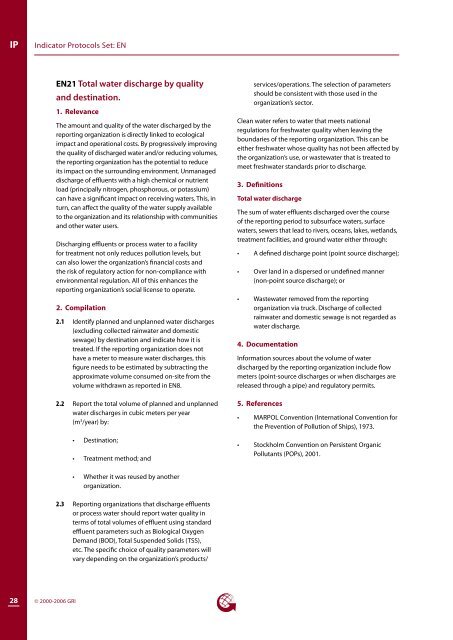Environment - Global Reporting Initiative
Environment - Global Reporting Initiative
Environment - Global Reporting Initiative
You also want an ePaper? Increase the reach of your titles
YUMPU automatically turns print PDFs into web optimized ePapers that Google loves.
IP<br />
Indicator Protocols Set: EN<br />
EN21 Total water discharge by quality<br />
and destination.<br />
1. Relevance<br />
The amount and quality of the water discharged by the<br />
reporting organization is directly linked to ecological<br />
impact and operational costs. By progressively improving<br />
the quality of discharged water and/or reducing volumes,<br />
the reporting organization has the potential to reduce<br />
its impact on the surrounding environment. Unmanaged<br />
discharge of effluents with a high chemical or nutrient<br />
load (principally nitrogen, phosphorous, or potassium)<br />
can have a significant impact on receiving waters. This, in<br />
turn, can affect the quality of the water supply available<br />
to the organization and its relationship with communities<br />
and other water users.<br />
Discharging effluents or process water to a facility<br />
for treatment not only reduces pollution levels, but<br />
can also lower the organization’s financial costs and<br />
the risk of regulatory action for non-compliance with<br />
environmental regulation. All of this enhances the<br />
reporting organization’s social license to operate.<br />
2. Compilation<br />
2.1 Identify planned and unplanned water discharges<br />
(excluding collected rainwater and domestic<br />
sewage) by destination and indicate how it is<br />
treated. If the reporting organization does not<br />
have a meter to measure water discharges, this<br />
figure needs to be estimated by subtracting the<br />
approximate volume consumed on-site from the<br />
volume withdrawn as reported in EN8.<br />
2.2 Report the total volume of planned and unplanned<br />
water discharges in cubic meters per year<br />
(m 3 /year) by:<br />
• Destination;<br />
• Treatment method; and<br />
services/operations. The selection of parameters<br />
should be consistent with those used in the<br />
organization’s sector.<br />
Clean water refers to water that meets national<br />
regulations for freshwater quality when leaving the<br />
boundaries of the reporting organization. This can be<br />
either freshwater whose quality has not been affected by<br />
the organization’s use, or wastewater that is treated to<br />
meet freshwater standards prior to discharge.<br />
3. Definitions<br />
Total water discharge<br />
The sum of water effluents discharged over the course<br />
of the reporting period to subsurface waters, surface<br />
waters, sewers that lead to rivers, oceans, lakes, wetlands,<br />
treatment facilities, and ground water either through:<br />
• A defined discharge point (point source discharge);<br />
• Over land in a dispersed or undefined manner<br />
(non-point source discharge); or<br />
• Wastewater removed from the reporting<br />
organization via truck. Discharge of collected<br />
rainwater and domestic sewage is not regarded as<br />
water discharge.<br />
4. Documentation<br />
Information sources about the volume of water<br />
discharged by the reporting organization include flow<br />
meters (point-source discharges or when discharges are<br />
released through a pipe) and regulatory permits.<br />
5. References<br />
• MARPOL Convention (International Convention for<br />
the Prevention of Pollution of Ships), 1973.<br />
• Stockholm Convention on Persistent Organic<br />
Pollutants (POPs), 2001.<br />
• Whether it was reused by another<br />
organization.<br />
2.3 <strong>Reporting</strong> organizations that discharge effluents<br />
or process water should report water quality in<br />
terms of total volumes of effluent using standard<br />
effluent parameters such as Biological Oxygen<br />
Demand (BOD), Total Suspended Solids (TSS),<br />
etc. The specific choice of quality parameters will<br />
vary depending on the organization’s products/<br />
28<br />
© 2000-2006 GRI

















